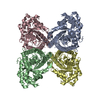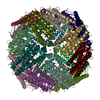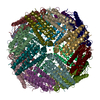+Search query
-Structure paper
| Title | Characterizing the resolution and throughput of the Apollo direct electron detector. |
|---|---|
| Journal, issue, pages | J Struct Biol X, Vol. 7, Page 100080, Year 2023 |
| Publish date | Dec 5, 2022 |
 Authors Authors | Ruizhi Peng / Xiaofeng Fu / Joshua H Mendez / Peter S Randolph / Benjamin E Bammes / Scott M Stagg /  |
| PubMed Abstract | Advances in electron detection have been essential to the success of high-resolution cryo-EM structure determination. A new generation of direct electron detector called the Apollo, has been ...Advances in electron detection have been essential to the success of high-resolution cryo-EM structure determination. A new generation of direct electron detector called the Apollo, has been developed by Direct Electron. The Apollo uses a novel event-based MAPS detector custom designed for ultra-fast electron counting. We have evaluated this new camera, finding that it delivers high detective quantum efficiency (DQE) and low coincidence loss, enabling high-quality electron counting data acquisition at up to nearly 80 input electrons per pixel per second. We further characterized the performance of Apollo for single particle cryo-EM on real biological samples. Using mouse apoferritin, Apollo yielded better than 1.9 Å resolution reconstructions at all three tested dose rates from a half-day data collection session each. With longer collection time and improved specimen preparation, mouse apoferritin was reconstructed to 1.66 Å resolution. Applied to a more challenging small protein aldolase, we obtained a 2.24 Å resolution reconstruction. The high quality of the map indicates that the Apollo has sufficiently high DQE to reconstruct smaller proteins and complexes with high-fidelity. Our results demonstrate that the Apollo camera performs well across a broad range of dose rates and is capable of capturing high quality data that produce high-resolution reconstructions for large and small single particle samples. |
 External links External links |  J Struct Biol X / J Struct Biol X /  PubMed:36578473 / PubMed:36578473 /  PubMed Central PubMed Central |
| Methods | EM (single particle) |
| Resolution | 1.66 - 2.24 Å |
| Structure data | EMDB-28147, PDB-8ehg: EMDB-28259, PDB-8emq: EMDB-28269, PDB-8en7: |
| Chemicals |  ChemComp-ZN:  ChemComp-FE:  ChemComp-HOH: |
| Source |
|
 Keywords Keywords | SUGAR BINDING PROTEIN /  glycolysis / METAL BINDING PROTEIN / bind with iron glycolysis / METAL BINDING PROTEIN / bind with iron |
 Movie
Movie Controller
Controller Structure viewers
Structure viewers About Yorodumi Papers
About Yorodumi Papers










